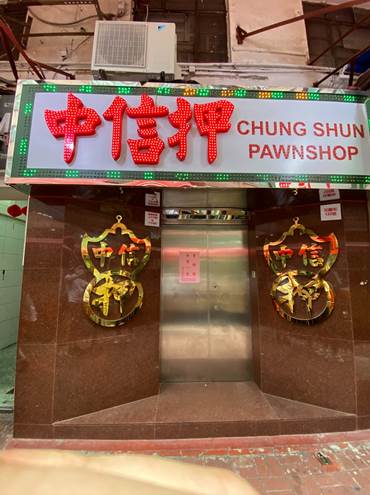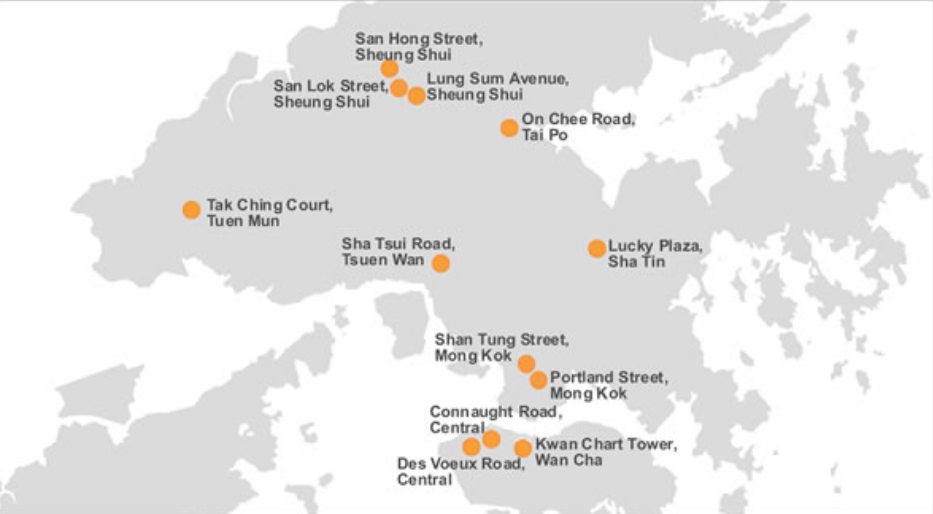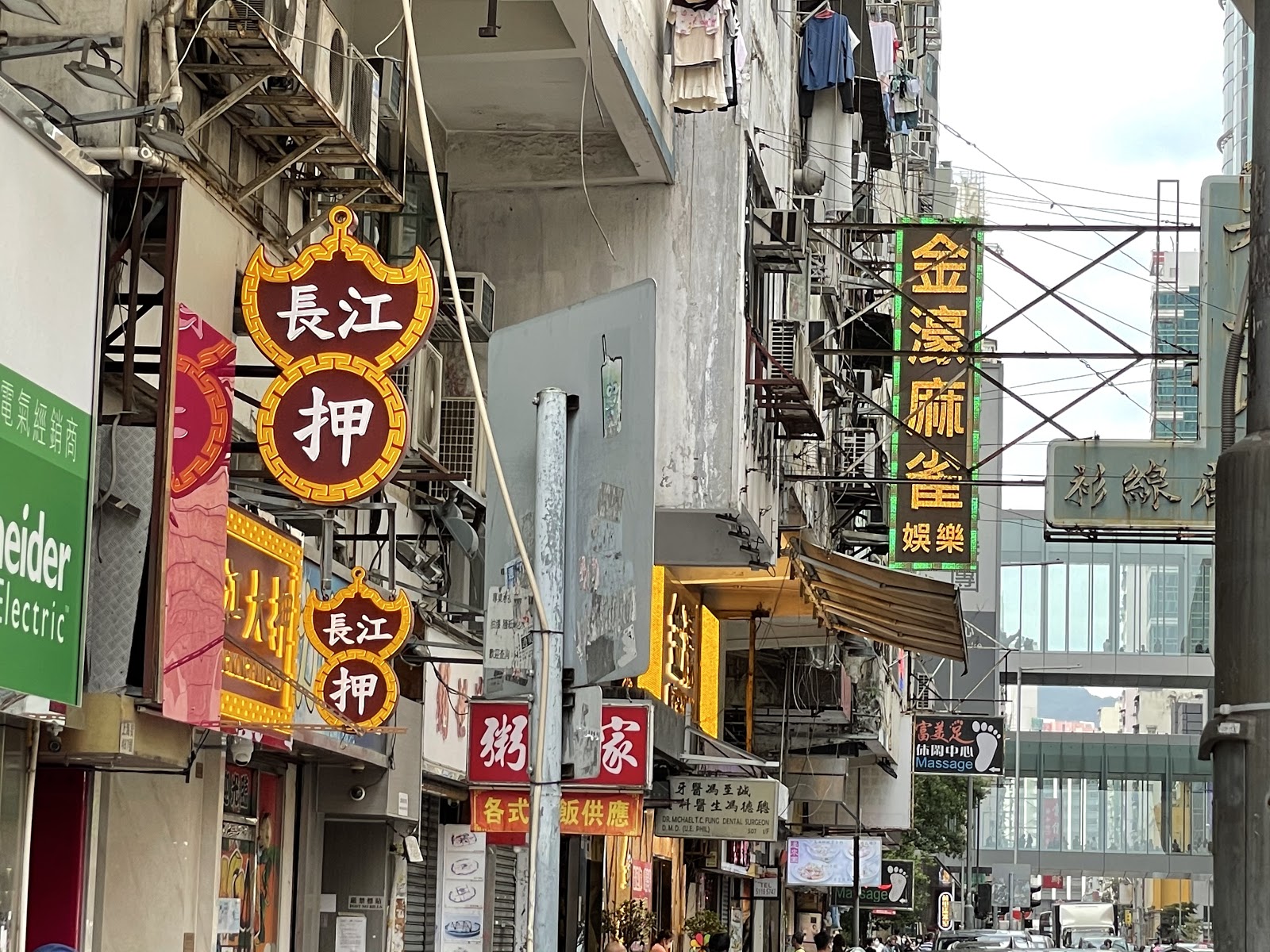1. Introduction
In Hong Kong, distinctive signboards of pawn shops are omnipresent. While the pawnbroking industry may be regarded as a “sunset industry”, there are still approximately 200 pawn shops in Hong Kong, a city where cut-throat competition and sky-rocketing high rent are found (HKPA, 2020). As an industry that witnessed the city’s growth for nearly 200 years, the development of the pawnbroking industry in Hong Kong was greatly associated with the city’s socio-economic development (see Figure 1).
It is blatant that the socio-economic development of Hong Kong is greatly influenced by other countries. For instance, the pawnbroking industry experienced significant expansion in the late-19th century when the city reformed as a major regional entrepôt and was then halted during the Japanese occupation.
To unveil the mystery behind the prosperity of the pawnbroking industry, our project casts light on how globalization influenced and transformed some characteristics of pawn shops in Hong Kong consequently, resulting in Hong Kong's contemporary pawn shop culture, using the perspective of cultural geography.
Table 1. Developmental stages of Hong Kong’s pawnbroking industry and its associated socioeconomic backgrounds.
(Sources: Cheng & Ko, 2016; Chui, 2015; Sze et al., 2013)
|
Stage |
Before
1842 |
1842-1926
1st Vigorous Expansion |
1926-1941: 1st Challenge & Stable Dev’t afterwards |
1941-1945:
A Halt |
1945-1990: 2nd Vigorous Expansion |
1990-present: Stable Development |
|
No. of pawn shops |
16 |
1890s-40 ⇒
1920s-135 |
~ 90 in early-1930s ⇒ develop stably afterwards |
/ |
1980s-160 |
200 (present) |
|
Events |
/ |
1842-Colonial rule in HK
(Fish Village --> Entrepôt/ Trading Centre) |
1932-World Econ Crisis
1937-JP’s Invasion of China |
1941-JP’s invasion of HK |
1945-Liberation
1979-Reform and Opening-up
1982&1988- Stock Market Crashes |
1997-Handover
2003-CEPA |
|
Other factors |
/ |
Influx of Population (businessman and workers)
-Population Growth |
-Gov’t monitoring from 1926
-Great competition among pawn shops |
Great demand of clothes in China |
Supportive attitude from colonial gov’t
-Influx of Population
-Economic transformation |
-Economic dev’t
-Competition from the financial industry |

Figure 1. A typical pawn shop in Hong Kong
(source: the authors)
2. Cultural geographical perspective in use
Globalization is a process, referring to the substance and spirit of the movement of products to break through the shackles of national boundaries, affecting every corner of the planet’s life. Apart from products, culture and technology are also spread through globalization, influencing and changing those from other countries.
Cultural geography states that traces, which are affected by context and culture, constitutes places. To illustrate the impacts of globalization on pawn shops, we will discuss how context and culture changed as a result of globalization. This affects people's beliefs and behaviours, contributing to the formation and transformation of material traces (screen doors and counters) and non-material traces (business models and trading methods) of pawn shops. As a result, the location, locale and sense of place of pawn shops change, indicating a change in place.

Figure 2. Cultural geographical perspective framework
(source: the authors)
3. Empirical analysis
3a. How globalization leads to changes in context and culture
The British colonization of Hong Kong had indeed marked the start of globalization and its impact on Hong Kong we see now. Due to globalisation, back in the 1950's, Hong Kong had had industrialization and financial market development (Schenk, Catherine, 2008). As a result, it improves the overall living standard of Chinese, which is shown in their increased expenditure on leisure and enjoyment. From then on, Chinese started to adopt the western, consumerist lifestyle in their daily lives, which allows ample of opportunities for the exchange and interaction of Chinese and western cultures in the future, which reforms the context and culture of pawn shops in Hong Kong.
3b. How material traces reflect changes due to globalization
Screen Doors
In the past, pawn shops had screen doors to block the view of passers-by and give customers more privacy to reduce their embarrassment (Mogul, 2020). With the blooming economy, prices skyrocketed and Hong Kong became more of a consumer society (Wang, 2015). The influx of western cultures through globalization also lowered the importance of the Chinese value to be self-sufficient (Terrill, 1977) so people became more willing to ask for help when needed. These decreased the shame and embarrassment of people having the need to borrow money (Chui, 2015), hence screen doors of pawn shops nowadays are just used as a decoration, indicating a change in material traces due to change in culture.
Counters
Back then, high counters were present in pawn shops, protected by bars for security. High counters were set to prevent people from seeing how pawnbrokers appraise the goods, which demonstrate the superior status of pawnbrokers over customers, aiming to lower customers’ bargaining power in order to increase monetary return (Annayiu, 2017) (Chui, 2020). However, the idea was then diminished due to globalization. In the early 1900s, the value of “The customer is always right” pioneered in Western societies (Blake, 2018). but the importance of customer services was first recognised in Hong Kong in 2002 (tc155, 2006). Therefore, it is strongly believed that the concept of equality or even prioritising customers affected pawn shops by then (Hunt, 2019). From then on, pawn shops have counters of regular height, where customers are able to communicate with pawnbrokers at eye level. Furthermore, the advancement and influx of foreign technology replaces the metal bars with modern security glass and CCTV for security (Chui, 2020).

Figure 3. Screen door and counter in a pawn shop
(source: the authors)
3c. How non-material traces reflect changes due to globalization
Business Models
Under globalization, the pawnbroking industry developed a more comprehensive business model in response to the high demand in society. Pawn shops nowadays started to raise funds from the stock market and cooperate with partners in search for significant trades in property mortgages or valuable pawn goods. Take Oiwahpawn as an example, it has over ten branches evenly distributed in Hong Kong. Each of its branches is responsible for different businesses and services, for instance, Tak Wan Pawnshop provides pawn and redemption services to the customers, while Kei Wah pawnshop offers mortgage and property valuation services to customers. Therefore, we can see that Pawn shops nowadays adopt chain operation, rather than just a single party, which aims to reach distinctive targets through wholly owned subsidiaries’ merger and acquisition (pawnshop.com.hk/en/index, 2020, retrieved November 10,2020).

Figure 4. Oiwahpawn - Detailed Address and Map of the chain stores
(source:https://www.pawnshop.com.hk/en/map)
Trading Methods
Globalization also brought challenges to pawn shops in Hong Kong. With the advancement of intercommunication, people tend to use mobile applications to exchange their products for money, such as Carousell (Carousell.com, 2020, retrieved November 10,2020), one of the most popular applications for customer-to-customer transactions. A simple comparison with these mobile applications can easily reveal the inconvenience of pawn shops nowadays. Therefore, some pawn shops improved their online assets valuation system in response. Using Oiwah Pawn Group as an example, they developed an advanced online system to evaluate the price of assets, so customers can know the worth of their goods instantly, helping modern pawn shops to reposition themselves in the Hong Kong’s pawnbroking market.

Figure 5. OiWah Pawnshop - Online Mortgage Evaluation and Process
(source: https://www.pawnshop.com.hk/en/mortgage)
3d. How place (location, locale, sense of place) changes as a result
Place is a concrete concept that changes with time. In our case, the place is changing with foreign cultural shocks and technological evolutions over time. Place, such as location refers to a particular cultural landscape or object that symbolises the combined work of human and nature (Sigrist ,2011); locale refers to a geographic place at which there is or was human activity (USGS, retrieved November 10,2020); sense of space refers to the perspectives and feelings that individuals or groups hold towards the geographical areas (Hoste, 2012).
Location
Number of pawn shops have undergone dramatic changes due to social development in Hong Kong (see Table 1.). Currently, there are approximately 200 pawn shops in Hong Kong, populated in Yau TsimMong district (HKPA, 2020). With technological globalization, pawn shops have also undergone computerization and digitization, where customers can pawn goods simply through electronic devices (see Figure 5.).
Locale
There are 66 premises issued with mahjong/Tin Kau Licence currently in Hong Kong. Within Yau Tsim Mong district, there are already 10 mahjong schools in Mong Kok present (Licensing Offices, 2020). We can see that there is a close relationship between Pawn shops and mahjong schools, which is proved in our field study. This allows gamblers to pawn goods with them to earn extra money and continue with gambling conveniently (Michael, 2019).

Figure 6. Close relationship between pawn shops and mahjong schools
(source: the authors)
Sense of place
Generally speaking, the older generations have a strong sense of belonging to pawn shops in Hong Kong, while the younger generations do not (Wong, M.H, 2019). Back in the Eastern Han Dynasty, the concept related to “pawning” was found in “ShuoWenJieZi” (zdic.net, retrieved November 10,2020), indicating that pawn shops play an important role in lending in the olden days. It was not until the 1950's that the lending system shifted from pawn shops to modern banks and financial institutions due to the globalisation of technology (SivaShankar, 2013). Being offered numerous choices of institutions for lending, most younger generations have less exposure to pawn shops, having less sense of belonging to pawn shops.
4. Conclusion
Growing with Hong Kong for nearly two centuries, the material and non-material traces of the local pawnbroking industry, including its architectural features, mode of business and operation, have greatly mirrored the city’s socio-economic development and the change of dominating ideologies over history as a result of globalization. Although the ever-changing status quo may pose challenges towards the development of pawn shops, the local pawnbroking industry has been resilient and flexible in responding to them accordingly. Hence, we strongly believe that the pawnbroking industry can stand firm in the future.
References
Annayiu. (2017)。<建築設計篇>。《當鋪-生存之秘》。取自https://passhonpropawnshop.wordpress.com/2017/05/01/%E5%BB%BA%E7%AF%89%E7%89%B9%E8%89%B2%E7%AF%87/
Blake, M. (2018). A Global View of “The Customer Is Always Right”. Retrieved from: https://www.forbes.com/sites/blakemorgan/2018/09/24/a-global-view-of-the-customer-is-always-right/?sh=13231d12236f
Cheng, W.T., & Ko, H. (2016) 。白手興家 : 香港家族與社會, 1841-1941 [Build a Home from Scratch: Family and Society of Hong Kong] 。香港: 中華書局(香港)有限公司。
Chui, C.P. (2015)。我哋當舖好有情 [ Our pawn shop good love ]。 香港: 突破出版社。
Chui, C.P.(2020)。〈當鋪設計- 從當鋪外觀到內部裝修〉[Design of Pawn Shops: From the exteriors to interior decoration]。《香港當舖遊蹤》[Tour of Pawn Shops in Hong Kong]。取自: https://www.jointpublishing.com/JointPublishing2013/media/Joint-Publishing/9789620446375-text-%E8%A9%A6%E8%AE%80%E9%A0%81.pdf?ext=.pdf
Costantini, I. (2019). Health, Education and Wellbeing in Hong Kong: British Legacy and Ne. Retrieved from: https://journals.openedition.org/interventionseconomiques/6472#tocto1n1


